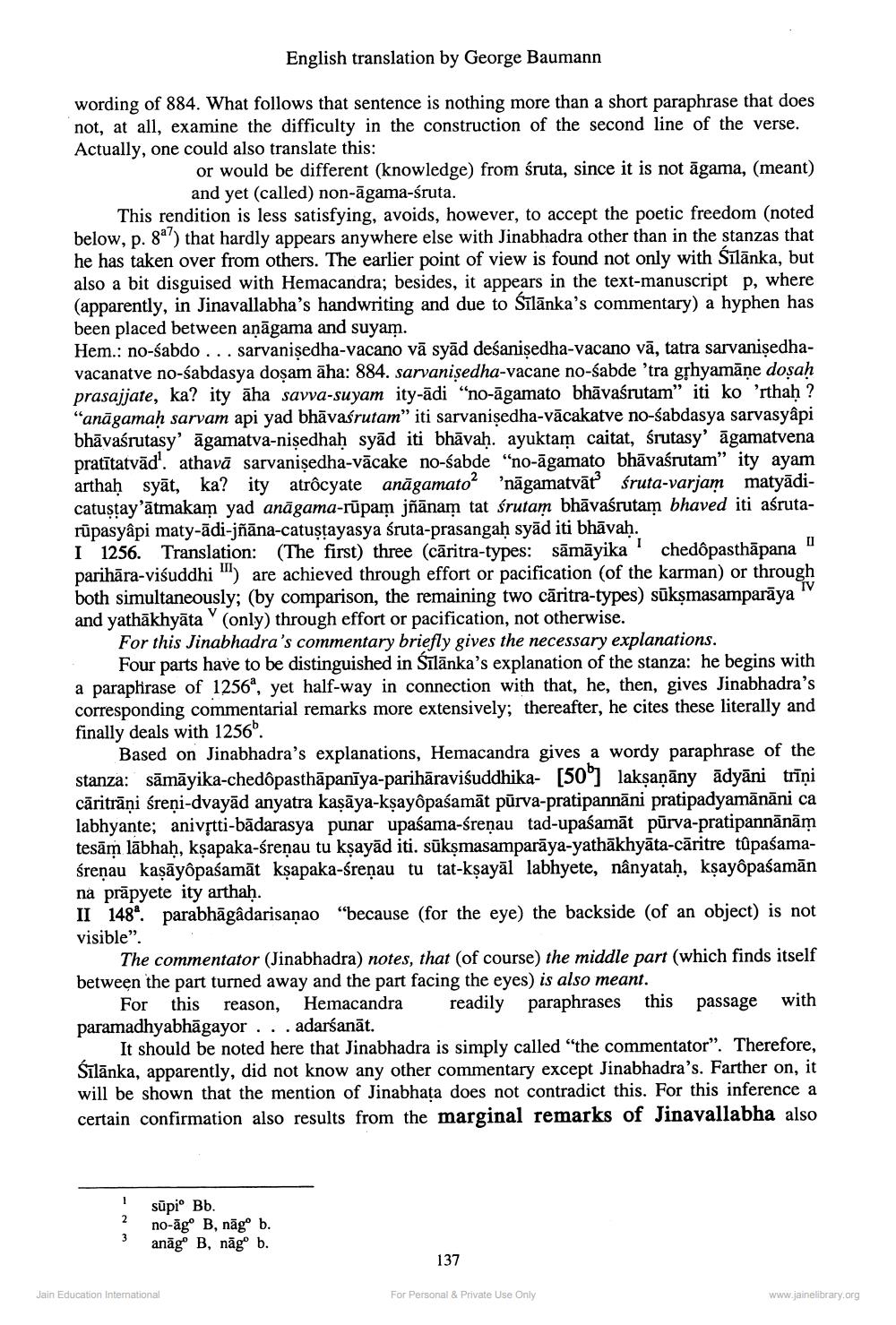________________
English translation by George Baumann
wording of 884. What follows that sentence is nothing more than a short paraphrase that does not, at all, examine the difficulty in the construction of the second line of the verse. Actually, one could also translate this:
or would be different (knowledge) from śruta, since it is not āgama, (meant)
and yet (called) non-āgama-śruta. This rendition is less satisfying, avoids, however, to accept the poetic freedom (noted below, p. 89') that hardly appears anywhere else with Jinabhadra other than in the stanzas that he has taken over from others. The earlier point of view is found not only with Śīlānka, but also a bit disguised with Hemacandra; besides, it appears in the text-manuscript p, where (apparently, in Jinavallabha's handwriting and due to Sīlānka's commentary) a hyphen has been placed between anāgama and suyam. Hem.: no-śabdo ... sarvanişedha-vacano vā syād deśanişedha-vacano vā, tatra sarvanişedhavacanatve no-śabdasya dosam āha: 884. sarvanisedha-vacane no-śabde 'tra grhyamāṇe dosah prasajjate, ka? ity āha savva-suyam ity-ādi "no-āgamato bhāvaśrutam" iti ko'rthah ? "anāgamaḥ sarvam api yad bhāvaśrutam" iti sarvanişedha-vācakatve no-sabdasya sarvasyâpi bhāvaśrutasy' āgamatva-nişedhah syād iti bhāvah. ayuktam caitat, śrutasy' āgamatvena pratītatvād!. athavā sarvanişedha-vācake no-śabde "no-āgamato bhāvaśrutam” ity ayam arthaḥ syāt, ka?ity atrocyate anāgamato? 'nāgamatvāt" śruta-varjam matyādicatuștay'ātmakam yad anāgama-rūpam jñānam tat śrutam bhāvaśrutam bhaved iti aśrutarūpasyâpi maty-ādi-jñāna-catustayasya śruta-prasangah syād iti bhāvah. I 1256. Translation: (The first) three (cāritra-types: sāmāyika' chedôpasthāpana" parihāra-viśuddhi") are achieved through effort or pacification (of the karman) or through both simultaneously; (by comparison, the remaining two cāritra-types) sūksmasamparāya " and yathākhyāta (only) through effort or pacification, not otherwise.
For this Jinabhadra's commentary briefly gives the necessary explanations.
Four parts have to be distinguished in Sīlānka's explanation of the stanza: he begins with a paraphrase of 1256, yet half-way in connection with that, he, then, gives Jinabhadra's corresponding commentarial remarks more extensively; thereafter, he cites these literally and finally deals with 1256'.
Based on Jinabhadra's explanations, Hemacandra gives a wordy paraphrase of the stanza: sāmāyika-chedôpasthāpanīya-parihāraviśuddhika- [50] laksanāny ādyāni trīņi cāritrāņi śreņi-dvayad anyatra kasāya-kşayopaśamāt pūrva-pratipannāni pratipadyamānāni ca labhyante; anivștti-bādarasya punar upaśama-śreņau tad-upaśamāt pūrva-pratipannānām tesām lābhah, kşapaka-śreņau tu kṣayād iti, sūksmasamparāya-yathākhyāta-cāritre tûpaśamaśreņau kasāyôpašamāt ksapaka-śreņau tu tat-kşayāl labhyete, nânyatah, kşayôpašamān na prāpyete ity arthah. II 1484 parabhāgâdarisaņao "because (for the eye) the backside (of an object) is not visible".
The commentator (Jinabhadra) notes, that (of course) the middle part (which finds itself between the part turned away and the part facing the eyes) is also meant.
For this reason, Hemacandra readily paraphrases this passage with paramadhyabhāgayor ... adarśanāt.
It should be noted here that Jinabhadra is simply called the commentator”. Therefore, Silānka, apparently, did not know any other commentary except Jinabhadra's. Farther on, it will be shown that the mention of Jinabhata does not contradict this. For this inference a certain confirmation also results from the marginal remarks of Jinavallabha also
2
sūpio Bb. no-āgo B, nägo b. anāgo B, nāgo b.
137
Jain Education International
For Personal & Private Use Only
www.jainelibrary.org




